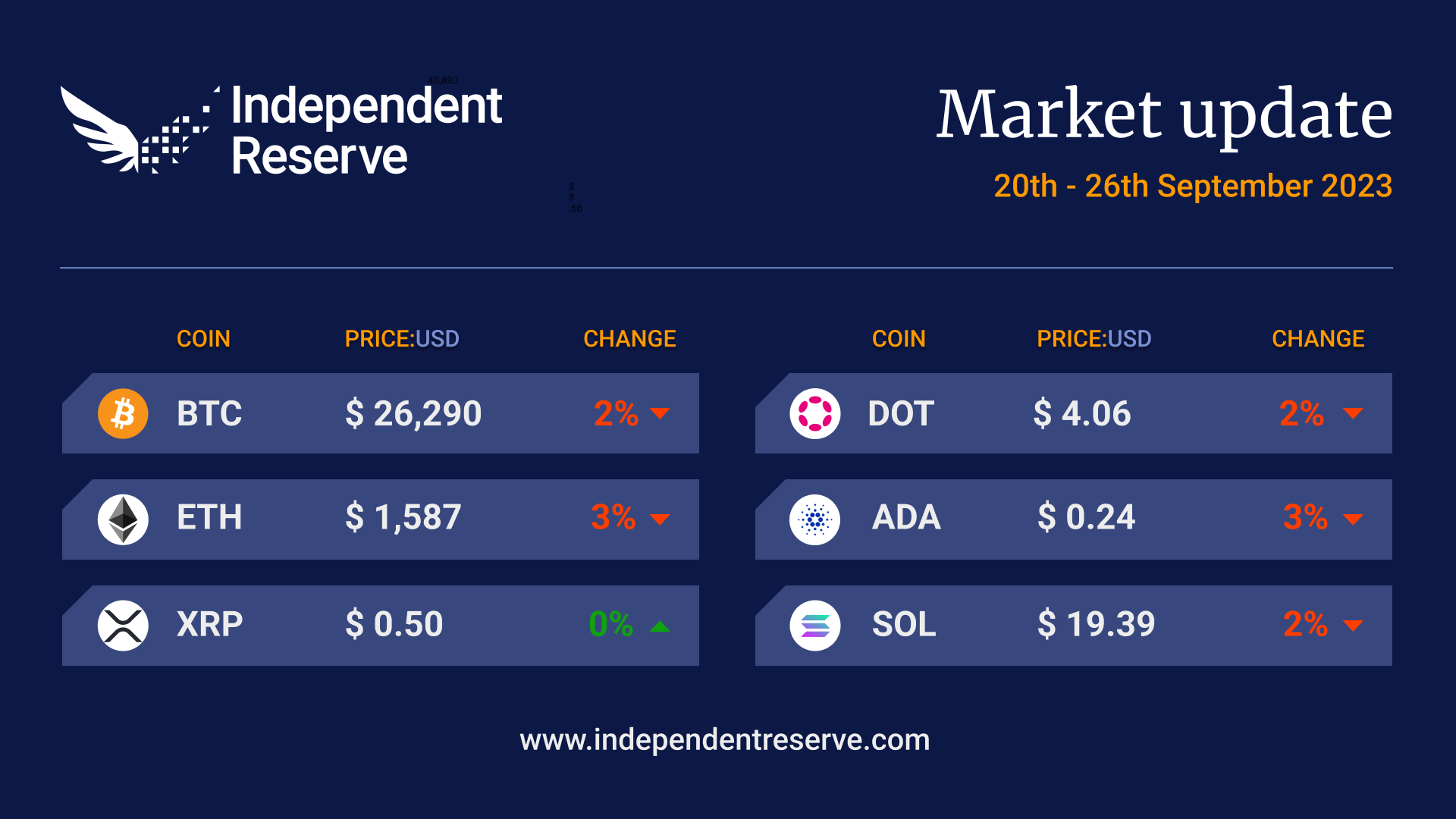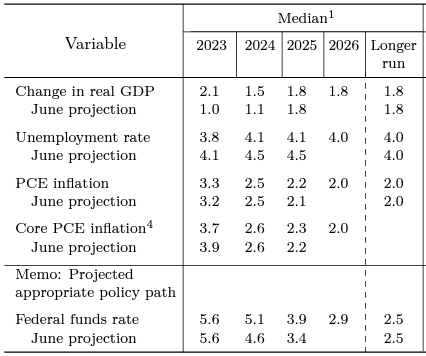In markets
Even MicroStrategy buying another 5,445 Bitcoin was not enough to overcome the resistance above US$27K (A$42K), and BTC finished the week down 2.1% on last week at US$26,285 (A$41,000) on the Bitcoin exchange in Australia. Ethereum fell 3.2% to US$1,587 (A$2,468). Ripple was flat, while other coins pulled back slightly: Cardano lost 3%, Dogecoin (-1.9%), Solana (-1.9%) and Polygon (-1.7%). The macro picture is looking complicated, with the Wall Street Journal reporting eight of 12 central banks this week left rates on hold, suggesting we are near the top of the cycle. But attention is now turning to the impact of those rises, and whether economies will slow faster than expected, particularly in Europe. In America, the regular insanity that is the political bun-fight over raising the debt ceiling is back, with a new deal needing to be reached by September 30 to avoid a government shutdown. The Crypto Fear and Greed index is at 47, or neutral.

From the OTC desk
Cryptocurrencies remain somewhat directionless, relative to traditional risk assets. This has been the case for the last three months. Price action in the cryptocurrency complex has been segmented, with pricing silos focusing on: tokens that provide a consistent and stable yield (think CRV, LDO); tokens associated with stable coin projects (think HBAR); and tokens that don’t earn yield (think BTC and other non-staking layer 1s).
It is the tokens that don’t provide yield that have priced more sensitively to global macro news and events. With a lack of volatility in the cryptocurrency complex, the broader cryptocurrency community is paying much closer attention to the macroeconomic news flow – this is likely to continue.
Additionally, the complex is still expected to trade with increased volatility around critical news releases and announces relating a US BTC ETF, as well as any SEC litigation outcome or announcement.
In traditional markets, last week was all about the US Federal Open Market Committee (FOMC). And while the broad consensus was for the federal rate to remain in a band of 5.25-5.50%, it was the forward guidance of the Committee which piqued interest.
The most notable changes to the FOMC’s Economic Projections include:

As outlined above, forecast increases in GDP and decreases in unemployment have led to a market conclusion that the path to inflation normalisation may occur with a ‘soft landing’. Further to this point, it is now only at the end of 2026 that the FOMC are forecasting PCE inflation to return to target – quite some distance away. This suggests that the FOMC are more comfortable that the current policy setting is ‘restrictive’ and will work to reduce inflation gradually, without significantly impacting growth and employment. This would be the ideal scenario for risk assets.
The practical reality of last week, turned out to be somewhat different, however, with the pricing of risk assets being challenged across the board. US 10yr bond yields moved above 4.50% (the highest yield since 2007) and the S&P 500 fell more than 2.5%. It was also reported that the 30yr fixed rate mortgage in the US had hit 7.75%. For the time being, the central bank narrative of interest rates being ‘higher for longer’ has outweighed the expectation of an economic soft landing.
In Australia, Wednesday at 11:30am AEST delivers the AU Monthly CPI Indicator for August. With global oil prices up more than 25% in the quarter, this data point will be examined closely to better understand the basing effects of Australia’s domestic inflation relative to energy. Market expectation is for the CPI monthly indicator to print 5.2% relative to a July reading of 4.9%. Watch this space.
On the OTC desk, trading volumes have continued to increase; with interest in alt tokens strengthening. In general, tokens that have an exposure to wholly backed stable coins are in vogue – and this feels like a theme that will remain for some time. While BTC and ETH flows appear more balanced, buying interest in USDT has remained. For now, flows in layer 1 tokens have remained quiet in this renewed shift in interest towards smaller market cap tokens.
For any further information, please feel free to reach out.
In headlines
A decade of Mt Gox
The ongoing Mt Gox saga will clock up an entire decade before creditors are repaid, with the trustee Nobuaki Kobayashi pushing the deadline for repayments back to Halloween 2024. For the 90% of people in crypto who weren’t around when the world’s biggest Bitcoin exchange Mt Gox collapsed in 2014, that may be good news, as fears over a big price dump when creditors are reunited with their Bitcoin is the last thing we need at this stage of the bear market. The Mt. Gox estate holds 142,000 Bitcoin (and a similar amount of Bitcoin Cash) as well as 69 million Japanese yen.
Celsius creditors doing better
Meanwhile, things are progressing faster with the collapse of crypto lender Celsius, with creditors voting in favour of a reorganisation plan that would distribute US$2 billion (A$3.1B) worth of Ether and Bitcoin to creditors. A New York bankruptcy court will rule on final approval on October 2. In its regular role of spoiler, the SEC has objected to Coinbase helping distribute the assets.
Anti-crypto crusader indicted
In a satisfying irony, anti-crypto US Senator Bob Menendez — who led the charge against Facebook for enabling “crypto scammer” ads and was opposed to El Salvador’s Bitcoin law — has been indicted on corruption charges. Prosecutors say that he accepted bribes to use his power as a lawmaker to benefit three New Jersey businessmen. Raids on his house found US$480,000 (A$747K) in alleged dirty money and US$100,000 (A$155K) in gold bars.
Grayscale Ether futures ETF application
Fresh from its Bitcoin ETF court victory against the SEC, Grayscale has filed an application for an Ether futures ETF. The application notes Grayscale Advisors is “in the process of becoming registered as a commodity pool operator with the Commodity Futures Trading Commission and is in the process of becoming a member of the National Futures Association.” A dozen other fund managers have also applied for Ether futures ETFs, which could come to market in October if approved. The Grayscale Bitcoin Trust is currently trading at a 20% discount to the value of the Bitcoin it holds, while the Ethereum Trust is at 27%.
JP Morgan is disappointed in Ethereum post-merge
JP Morgan analyst Nikolaos Panigirtzoglou says that Ethereum network activity since the Merge has been “disappointing”.
“While the shift from proof-of-work to proof-of-stake that resulted from the Merge upgrade meant that the energy consumption for the Ethereum network collapsed by more than 99%, the Ethereum supply is shrinking and staking rose sharply (with the amount of Ether staked up by 50% since the Shanghai upgrade), the increase in network activity has been rather disappointing,” the analyst wrote in a note to clients. Daily transactions, active addresses and TVL have all declined, and while activity on layer 2 network Optimism increased, activity on L2 Arbitrum decreased. Rounding out the bearish analysis, JP Morgan also noted centralisation concerns around staking on Lido. Influencer Lark Davis responded, “Dudes, it is a bear market, chill.”
Who controls 5% of the Bitcoin supply?
Even after this week’s purchase, if you thought that MicroStrategy was the largest holder of Bitcoin in the world, you’d be wrong. While it has 152,000 Bitcoin and certainly owns more than anyone else, Arkham Intelligence has determined that US exchange Coinbase is in control of 1 million Bitcoins, or about 5% of all Bitcoin in existence. That US$25 billion (A$39B) worth of Bitcoin is mostly owned by users, however, and the company itself only has around 10,000 BTC on its own books. Some Bitcoiners reacted with alarm that a single centralizsed exchange is in control of such a large amount of the supply.

Hopium No.1: China capital flight to pump Bitcoin
Capital outflows from China hit US$49 billion (A$76B) in August, the largest figure since December 2015. Some of the capital fleeing the country amid the slow recovery from the pandemic shutdown could end up in Bitcoin, according to Markus Thielen, head of research and strategy at Matrixport. The country’s strict capital controls mean that crypto is one of the few channels available to get money out. “The familiarity of Bitcoin by Chinese investors in times of a weakening domestic economy could see substantial inflows into Bitcoin over the next few months,” he said. While former BitMEX CEO Arthur Hayes pointed to something similar happening with gold, Singular Research crypto analyst Edward Engel told Cointelegraph he did not believe in the theory.
Hopium No.2: Bitcoin halving cycle 85% complete
Crypto markets may seem dead right now, but the good news is that we are 85% of the way through the cycle to the next halving around Anzac Day next year. That’s when the block reward for Bitcoin mining is cut in half, reducing the supply of new Bitcoin, which theoretically could increase the price. The halving cycles have been pretty reliable historically, although there’s a lot of debate over the actual drivers. The percentage of the Bitcoin supply held by long-term holders is also close to an all-time high, which in previous cycles signalled the bottom was in. So the bad signs are all good.
Hong Kong’s SFC takes steps toward publishing crypto exchange license applicants
In the aftermath of the JPEX probe and multiple arrests, Hong Kong’s Securities and Futures Commission (SFC) plans to publish a list of crypto exchange license applicants to enhance market transparency and investor awareness. The SFC aims to better educate the public about the risks associated with unregulated virtual asset trading platforms. Hong Kong’s Chief Executive, John Lee, stressed the need for crypto platforms to be SFC-licensed to protect investors.
Meanwhile, JPEX has recently filed a deregistration application with the Australian Securities and Investment Commission (ASIC).
Until next week, Happy Trading!


